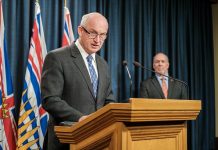
THE Province announced on Tuesday that it is improving the safety of British Columbians and protecting communities by investing $6.5 million in 10 disaster-mitigation projects throughout the province.
“Being prepared and planning ahead is paramount to protecting public safety and ensuring the economic health of our communities,” said Mike Farnworth, Minister of Public Safety and Solicitor General. “This investment will help make sure communities have the information they need and safeguards are in place, to better protect their citizens, critical infrastructure and livelihoods in an emergency.”
The 10 high-priority projects support seismic safety, avalanche risk assessment, flood protection and mitigation, and wildfire preparedness planning at the community level.
“These projects will help us build safe and secure communities and support our goal of ensuring all British Columbians are prepared for an emergency,” said Jennifer Rice, Parliamentary Secretary for Emergency Preparedness.
Funding highlights include:
* $2.6 million to plan and undertake structural and non-structural flood-mitigation projects in various locations throughout B.C.;
* $1.75 million to further assess earthquake-related hazards in the Metro Vancouver area;
* $1.5 million to the Union of British Columbia Municipalities (UBCM) for the Community Emergency Preparedness Fund;
* $450,000 to the Fire Chiefs Association of British Columbia to support road rescue, fire safety and prevention; and
* $130,000 to Avalanche Canada and the District of Stewart to support avalanche reporting and mapping.
“The weather in the Okanagan is changing,” said Anna Warwick Sears, Executive Director of the Okanagan Basin Water Board, about the funding it received.
As climate scientists warn that “extreme fluctuations will only become increasingly common,” she added that the level of collaboration that this project demonstrates – with local governments, the Okanagan Nation Alliance, its member communities, and the B.C. government – is all the more important.
“Everyone is working together, and all will benefit,” Warwick Sears said.
This funding is part of Emergency Management BC’s annual operating budget. Projects were chosen based on hazard risk, how quickly local governments could initiate activities and the benefit to the community.
This investment builds on the $10.7 million in funding announced in February 2018 by the governments of B.C. and Canada to support 30 flood-mitigation projects throughout the province.
Quick Facts:
* Emergency Management BC is the Province’s lead coordinating agency for all emergency management activities, including preparedness, response, mitigation and recovery.
* April 8-14 is Tsunami Preparedness Week in B.C., which aims to educate British Columbians about their risks and which sections of the coast are most vulnerable, and how to prepare and what to do in the event of an immediate threat.
* As part of Tsunami Preparedness Week, the B.C. government launched a new earthquake and tsunami guide. The aim is to help British Columbians understand how best to prepare for a disaster.
* The last major tsunami to hit B.C. shores was on March 27, 1964, when waves hit the B.C. coast, and Port Alberni was inundated with water following the 9.2-magnitude Great Alaska Earthquake. Those living within a tsunami zone need to learn about the risks, and how to prepare with at least 72 hours’ worth of water, food and emergency supplies.











